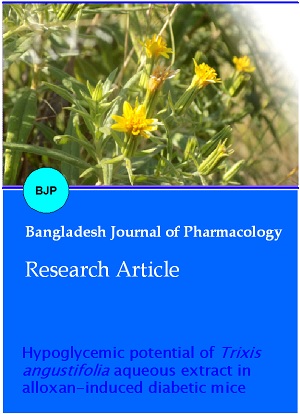Hypoglycemic potential of Trixis angustifolia aqueous extract in alloxan-induced diabetic mice
DOI:
https://doi.org/10.3329/bjp.v14i2.39254Keywords:
Alloxan, Diabetes, Hypoglycemia, Mouse, Trixis angustifoliaAbstract
The aim of the present study was to evaluate the hypoglycemic potential of Trixis angustifolia in alloxan-induced diabetic mice. An intragastric administration of the aqueous extract (50, 100 and 200 mg/kg) prepared from the aerial parts of T. angustifolia was evaluated. The treatment with the extract at 100 mg/kg produced a significant lowered (30.5%) of the blood glucose levels in diabetic mice after 15 days of daily oral administration. In addition, the extract induced a significant decrease in serum total cholesterol, low density lipoprotein whereas increased the high-density lipoprotein level. Additionally, the presence of alkaloids, cumarins, saponins, flavonoids and reducing sugars were identified in the extract. These findings provide a basis explaining the traditional folk medicine use of this plant as a hypoglycemic agent by the Mexican people.
Video Clip of Methodology:
5 min 16 sec: Click to watch
Downloads
199
118 Read
31

Published
How to Cite
Issue
Section
License
Authors who publish with this journal agree to the following terms:
- Authors retain copyright and grant the journal right of first publication with the work simultaneously licensed under a Creative Commons Attribution License that allows others to share the work with an acknowledgement of the work's authorship and initial publication in this journal.
- Authors are able to enter into separate, additional contractual arrangements for the non-exclusive distribution of the journal's published version of the work (e.g., post it to an institutional repository or publish it in a book), with an acknowledgement of its initial publication in this journal.
- Authors are permitted and encouraged to post their work online (e.g., in institutional repositories or on their website) prior to and during the submission process, as it can lead to productive exchanges, as well as earlier and greater citation of published work (See The Effect of Open Access).
